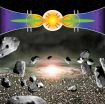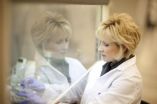(Press-News.org) ATLANTA – Children with brain lesions suffered before or around the time of birth are able to use gestures – an important aspect of the language learning process– to convey simple sentences, a Georgia State University researcher has found.
Şeyda Özçalışkan, assistant professor of psychology, and fellow researchers at the University of Chicago, looked at children who suffered lesions to one side of the brain to see whether they used gestures similar to typically developing children. She examined gestures such as pointing to a cookie while saying "eat" to convey the meaning "eat cookie," several months before expressing such sentences exclusively in speech.
"We do know that children with brain injuries show an amazing amount of plasticity (the ability to change) for language learning if they acquire lesions early in life," Özçalışkan said. "However, we did not know whether this plasticity was characterized by the same developmental trajectory shown for typically developing children, with gesture leading the way into speech. We looked at the onset of different sentence constructions in children with early brain injuries, and wanted to find out if we could see precursors of different sentence types in gesture.
"For children with brain injuries, we found that this pattern holds, similar to typically developing children," she said. "Children with unilateral brain injuries produce different kinds of simple sentences several months later than typically developing children. More important, the delays we observe in producing different sentences in speech are preceded by a similar delay in producing the same sentences in gesture-speech combinations."
Children with brain injuries also had a more difficult time in producing complex sentences across gesture and speech, such as conveying relationships between actions, for example saying "help me do it" while making a painting gesture.
"This in turn was later reflected in a much narrower range of complex sentence types expressed in their speech," Özçalışkan said. "This suggested to us, in general, that producing sentences across gesture and speech may serve as an embodied sensorimotor experience, that might help children take the next developmental step in producing these sentences in speech.
"And if you bypass the gesture-speech combination stage, that might negatively affect developing a broader representation of complex sentence types in speech."
The researchers also compared children with smaller brain lesions against children with large lesions, and found more of a delay in producing sentences, both in speech and in gesture-speech combinations, in children with large lesions.
The research has implications for developing interventions to help children with the language learning process, "as it shows that gestures are integral to the process of language learning even when that learning is taking place in an injured brain," Özçalışkan said.
"When children do different kinds of sentence combinations across gesture and speech, that's like a signal to the caregiver that 'I'm ready for this,'" she said. "The caregiver can then provide relevant input to the child, and that could in turn help the child take the next developmental step in producing that sentence entirely in speech."
###
The other researchers included Susan C. Levine and Susan Goldin-Meadow of the University of Chicago.
The research, "Gesturing with an injured brain: How gesture helps children with early brain injury learn linguistic connections," was published in the Journal of Child Language.
The article is available on the web at http://journals.cambridge.org/abstract_S0305000912000220 or upon request from Public Relations and Marketing Communications at 404-413-1357 or jcraig@gsu.edu.
For more about psychology at Georgia State, visit www.gsu.edu/psychology.
Children with brain lesions able to use gestures important to language learning
2013-02-20
ELSE PRESS RELEASES FROM THIS DATE:
The ethics of access: Comparing 2 federal health care reform efforts
2013-02-20
ANN ARBOR, Mich. — Two major health reform laws, enacted 25 years apart, both try to meet an ethical standard to provide broad access to basic health care. Neither quite gets there -- but it's not too late for modern health care reform to bring the nation closer to a goal of comprehensive and coordinated care for all.
That's the conclusion of a commentary published in the new issue of the Journal of the American Medical Association by a team of University of Michigan Health System physicians.
The authors – a family physician, an emergency physician and a primary care ...
Smoking cessation in old age: Less heart attacks and strokes within 5 years
2013-02-20
Professor Hermann Brenner and colleagues analyzed the data of 8.807 individuals aged between 50 and 74 years using data of Saarland citizens. "We were able to show that the risk of smokers for cardiovascular diseases is more than twice that of non-smokers. However, former smokers are affected at almost the same low rate as people of the same age who never smoked," says Brenner. "Moreover, smokers are affected at a significantly younger age than individuals who have never smoked or have stopped smoking." For example, a 60-year-old smoker has the same risk of myocardial infarction ...
Setting the record straight on Medicare's overhead costs: New study
2013-02-20
The traditional Medicare program allocates only 1 percent of total spending to overhead compared with 6 percent when the privatized portion of Medicare, known as Medicare Advantage, is included, according to a study in the June 2013 issue of the Journal of Health Politics, Policy and Law.
The 1 percent figure includes all types of non-medical spending by the Centers for Medicare and Medicaid Services plus other federal agencies, such as the IRS, that support the Medicare program, and is based on data contained in the latest report of the Medicare trustees. The 6 percent ...
MIT researchers build Quad HD TV chip
2013-02-20
CAMBRIDGE, MA -- It took only a few years for high-definition televisions to make the transition from high-priced novelty to ubiquitous commodity — and they now seem to be heading for obsolescence just as quickly. At the Consumer Electronics Show (CES) in January, several manufacturers debuted new ultrahigh-definition, or UHD, models (also known as 4K or Quad HD) with four times the resolution of today's HD TVs.
In addition to screens with four times the pixels, however, UHD also requires a new video-coding standard, known as high-efficiency video coding, or HEVC. Also ...
Gains made towards treatment of rare bone disease
2013-02-20
This press release is available in French.
Diagnosed in toddlers, X-linked hypophosphatemia (XLH) is the most common form of heritable rickets, in which soft bones bend and deform, and tooth abscesses develop because infections penetrate soft teeth that are not properly calcified. Researchers at McGill University and the Federal University of Sao Paulo have identified that osteopontin, a major bone and tooth substrate protein, plays a role in XLH. Their discovery may pave the way to effectively treating this rare disease.
The findings were made by the laboratories ...
Searching for the solar system's chemical recipe
2013-02-20
By studying the origins of different isotope ratios among the elements that make up today's smorgasbord of planets, moons, comets, asteroids, and interplanetary ice and dust, Mark Thiemens and his colleagues hope to learn how our solar system evolved. Thiemens, Dean of the Division of Physical Sciences at the University of California, San Diego, has worked on this problem for over three decades.
In recent years his team has found the Chemical Dynamics Beamline of the Advanced Light Source (ALS) at the U.S. Department of Energy's Lawrence Berkeley National Laboratory ...
Handheld device for detecting counterfeit and substandard medicines tested by PQM
2013-02-20
Rockville, Md., February 13, 2013 – With substandard and counterfeit medicines a dangerous and growing problem in the developing world and elsewhere, identifying new technologies to detect such drugs is an urgent matter. In a new study published in the Journal of Pharmaceutical and Biomedical Analysis, scientists from the U.S. Pharmacopeial Convention (USP) evaluated a handheld Raman device's potential to detect counterfeit and substandard medicines. The device, called TruScan®, is currently used to test Active Pharmaceutical Ingredients (API) and finished pharmaceutical ...
Mushroom-supplemented soybean extract shows therapeutic promise for advanced prostate cancer
2013-02-20
(SACRAMENTO, Calif.) — A natural, nontoxic product called genistein-combined polysaccharide, or GCP, which is commercially available in health stores, could help lengthen the life expectancy of certain prostate cancer patients, UC Davis researchers have found.
Paramita GhoshMen with prostate cancer that has spread to other parts of the body, known as metastatic cancer, and who have had their testosterone lowered with drug therapy are most likely to benefit. The study, recently published in Endocrine-Related Cancer, was conducted in prostate cancer cells and in mice.
Lowering ...
Power connects decision makers to the future
2013-02-20
Decision makers who feel powerful and in control of resources are more likely than others to make decisions that will benefit their future selves, according to researchers at the USC Marshall School of Business.
Conversely, those who lack feelings of power tend to prefer smaller immediate gains – those that benefit the present self – to potentially greater benefits in the future, according to "Power and Reduced Temporal Discounting," a research paper by Nathanael Fast, an assistant professor of management and organization at and Priyanka Joshi, a doctoral candidate ...
International space station plays host to innovative infectious disease research
2013-02-20
Performing sensitive biological experiments is always a delicate affair. Few researchers, however, contend with the challenges faced by Cheryl Nickerson, whose working laboratory aboard the International Space Station (ISS) is located hundreds of miles above the Earth, traveling at some 17,000 miles per hour.
Nickerson, a microbiologist at Arizona State University's Biodesign Institute, is using the ISS platform to pursue new research into the effects of microgravity on disease-causing organisms.
Nickerson presented her research findings and charted the course for ...

